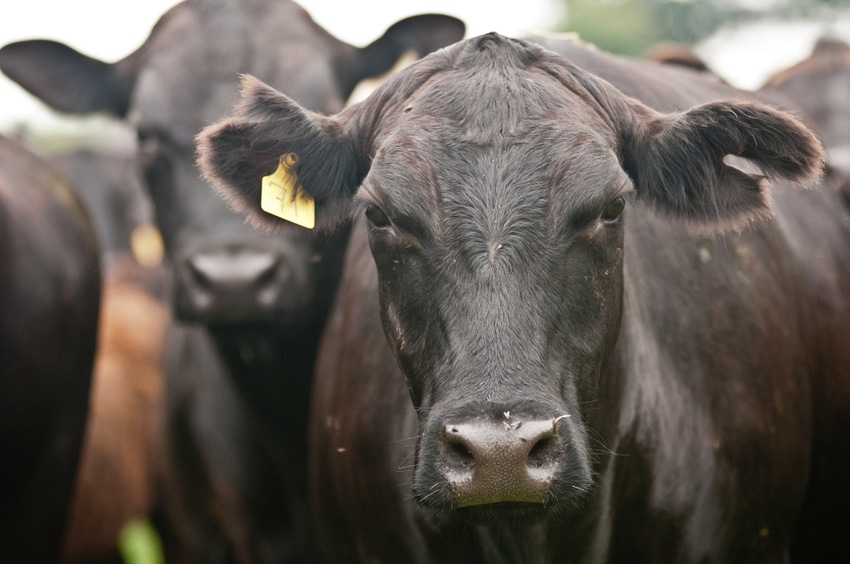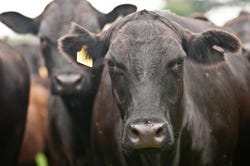June 25, 2015

In the heat of summer, one of the most important things cattle need to maintain optimal health is water. A decrease in water consumption can negatively impact health, reproduction and growth. Furthermore, when stock dams or pond water levels get low, excessive salt levels can cause major problems. Do you know how your water quality measures up?
In my fourth and final installment of my June Summer Herd Health series, we take look at important factors that impact water quality.
But first, in case you missed the previous installments in the series, check out these three blog posts:
Part 1: Symptoms of nutrient deficiencies; PLUS: 5 mineral supplementation tips
Part 2: 5 risk factors for summer pneumonia in calves
Part 3: Ranchers seeking large animal vets for maintaining herd health
Here are five things ranchers should keep in mind about maintaining quality livestock drinking water:
1. Know how much water your cattle need.

Photo Credit: USDA
According to Gene Parker, DVM, Oklahoma State University veterinarian, “Water consumption is dependent on many factors. Water intake for dry beef cows is around 1-1½ gallons per 100 pounds of body weight and this estimate can double for cows nursing calves.”
2. Be aware of potential contaminants.
Parker says nitrates should be at 100 ppm or less and warns producers to be aware of additive effects when animals are eating feed that has increased levels of nitrates (sudan, haygrazer and johnsongrass). About sulfates, he writes, “Water levels of 2,000-2,500 ppm and sulfate levels in foodstuffs allowing the animal to attain a level of 4,000 ppm or greater can be associated with a neurological disease in cattle causing blindness.”
3. Watch for excessive salts.
“Waters at 5,000-6,999 ppm (of dissolved salts) can be used with reasonable safety for dairy and beef cattle, sheep, pigs, and horses,” Parker writes. “However, it may be well to avoid the use of waters approaching the higher levels for pregnant and lactating animals. At 7,000-10,000 ppm, remove the italics these waters are unfit for pigs. Considerable risk may exist in using them for pregnant and lactating livestock. In general, their use should be avoided, although older animals may subsist on them for long periods of time under conditions of maintenance and low stress. At greater than 10,000 ppm, the risk of these high salinity waters is so great that they cannot be recommended for use under any conditions.”
READ: Rules of thumb for livestock drinking water quality
4. Know what factors might limit water consumption.
According to Rory Lewandowski, Ohio State University Extension educator for Wayne County, “The quantity of water consumed can be influenced by quality factors such as odor, taste, physical and chemical properties, mineral content, toxic compounds and microbial contamination. If quality is not adequate, then consumption decreases which can affect animal performance and health.”
Lewandowski encourages producers to test their water. A water quality lab analysis looks at several factors including: pH, total dissolved solids, nitrate nitrogen, sulfate, hardness, calcium, magnesium, potassium, sodium, copper, manganese, zinc and iron.
READ: Livestock need good quality drinking water
5. Is the water too hot?
Lewandowski writes, “A final consideration that may or may not be defined as water quality but can definitely influence water consumption is water temperature. Cattle prefer drinking water at temperatures between 40-65°F. When the water temperature gets above 80°F, intake often decreases.”
Do you worry about water quality in your stock dams, ponds and water tanks? Why or why not? Share your thoughts in the comments section below.
The opinions of Amanda Radke are not necessarily those of beefmagazine.com or Penton Agriculture.
You might also like:
60 stunning photos that showcase ranch work ethics
Picture perfect summer grazing scenes from readers
7 U.S. cattle operations honored for stewardship efforts
How to prevent foot rot in cattle
What's the least expensive way to breed cows? It might not be what you think
You May Also Like



